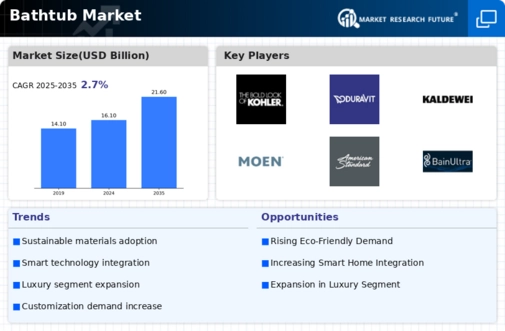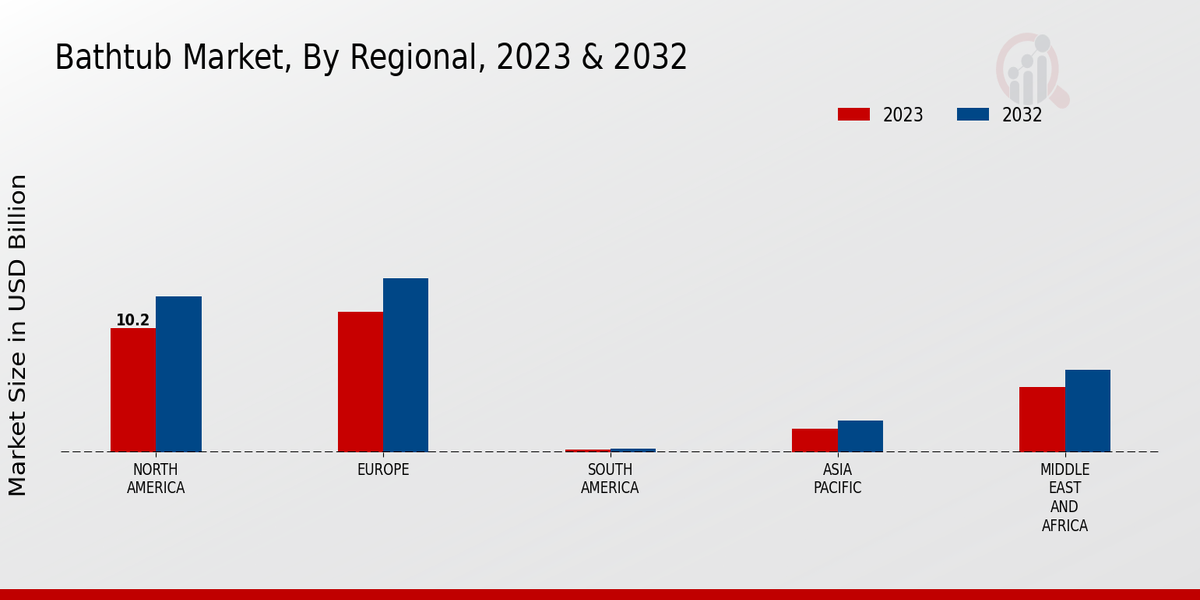Market Growth Projections
The Global Bathtub Market Industry is projected to experience steady growth over the coming years, with significant financial metrics indicating a positive trajectory. By 2035, the market is expected to reach 21.6 USD Billion, reflecting an increasing consumer investment in bathroom fixtures. The anticipated compound annual growth rate (CAGR) of 2.71% from 2025 to 2035 suggests a stable expansion phase, driven by factors such as urbanization, technological advancements, and changing consumer preferences. This growth is indicative of a broader trend within the home improvement sector, where bathtubs play a pivotal role in enhancing residential value and comfort.
Influence of Home Renovation Trends
The Global Bathtub Market Industry is significantly influenced by home renovation trends, as homeowners increasingly invest in upgrading their living spaces. The desire to enhance comfort and aesthetics drives the demand for modern bathtubs, which are often seen as focal points in bathroom design. As renovation projects become more prevalent, the market is poised for growth, with projections indicating a value of 16.1 USD Billion in 2024. This trend is further supported by the rise of DIY home improvement initiatives, where consumers seek to personalize their spaces. The interplay between renovation trends and bathtub demand suggests a robust market outlook as homeowners prioritize bathroom upgrades.
Urbanization and Housing Development
Urbanization is a significant driver of the Global Bathtub Market Industry, as more individuals migrate to urban areas seeking better opportunities. This demographic shift necessitates the construction of new residential buildings, which often include modern bathrooms equipped with bathtubs. As cities expand, the demand for housing increases, leading to a projected market value of 21.6 USD Billion by 2035. The integration of bathtubs in new housing developments aligns with contemporary design trends, enhancing the appeal of residential properties. Consequently, urbanization not only influences market dynamics but also shapes consumer preferences towards stylish and functional bathroom fixtures.
Sustainability and Eco-Friendly Products
Sustainability is becoming increasingly important in the Global Bathtub Market Industry, as consumers and manufacturers alike prioritize eco-friendly products. The growing awareness of environmental issues has led to a demand for bathtubs made from sustainable materials and those that promote water conservation. Manufacturers are responding by developing products that meet these criteria, which not only appeal to environmentally conscious consumers but also comply with regulatory standards. This shift towards sustainability is expected to drive market growth, as more consumers seek to reduce their ecological footprint while enjoying luxury bathing experiences. The industry's commitment to sustainability may also enhance brand loyalty among consumers.
Rising Consumer Preference for Luxury Bathrooms
The Global Bathtub Market Industry is experiencing a notable shift as consumers increasingly favor luxury bathroom designs. This trend is driven by a growing emphasis on personal wellness and relaxation, leading to higher demand for premium bathtubs. In 2024, the market is projected to reach 16.1 USD Billion, reflecting the rising investment in home improvement and luxury amenities. As homeowners seek to create spa-like environments, manufacturers are responding with innovative designs and materials. This consumer behavior suggests a sustained growth trajectory, as the industry adapts to meet the evolving expectations of discerning customers.
Technological Advancements in Bathtub Manufacturing
Technological innovations play a crucial role in shaping the Global Bathtub Market Industry. Advances in materials and manufacturing processes have led to the creation of bathtubs that are not only aesthetically pleasing but also more durable and easier to maintain. For instance, the introduction of acrylic and composite materials has revolutionized bathtub design, offering consumers a wider range of options. These advancements are likely to contribute to a compound annual growth rate (CAGR) of 2.71% from 2025 to 2035, as manufacturers continue to invest in research and development. The ability to produce customized bathtubs further enhances market competitiveness, catering to diverse consumer needs.













